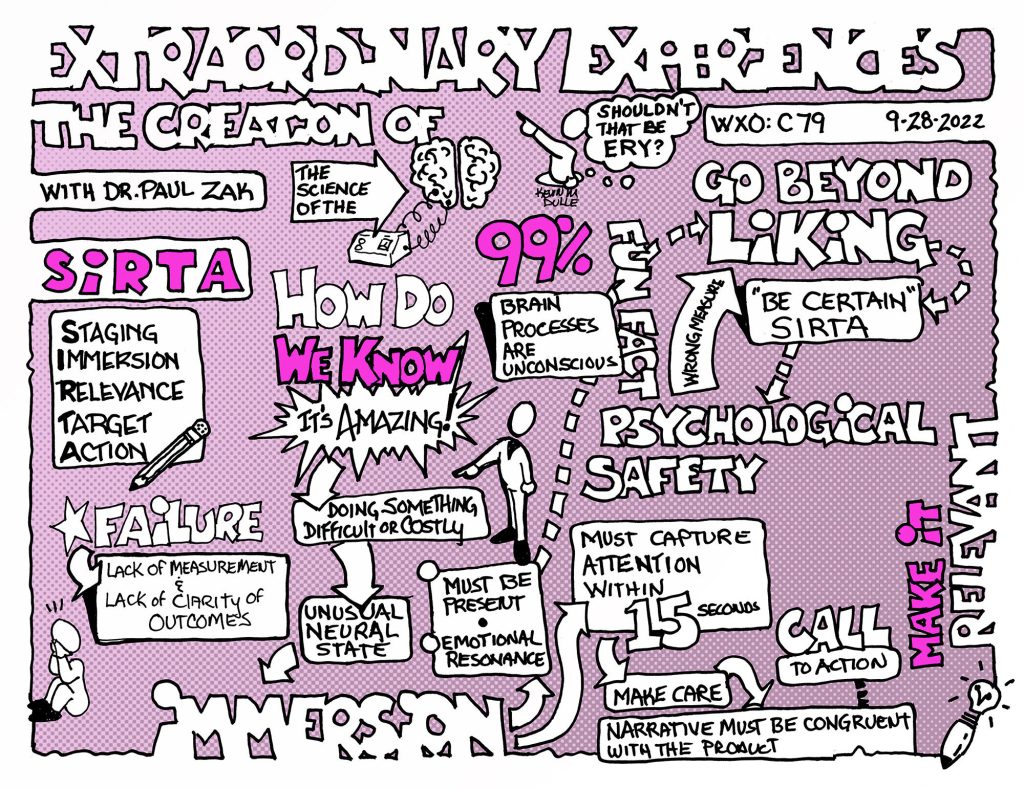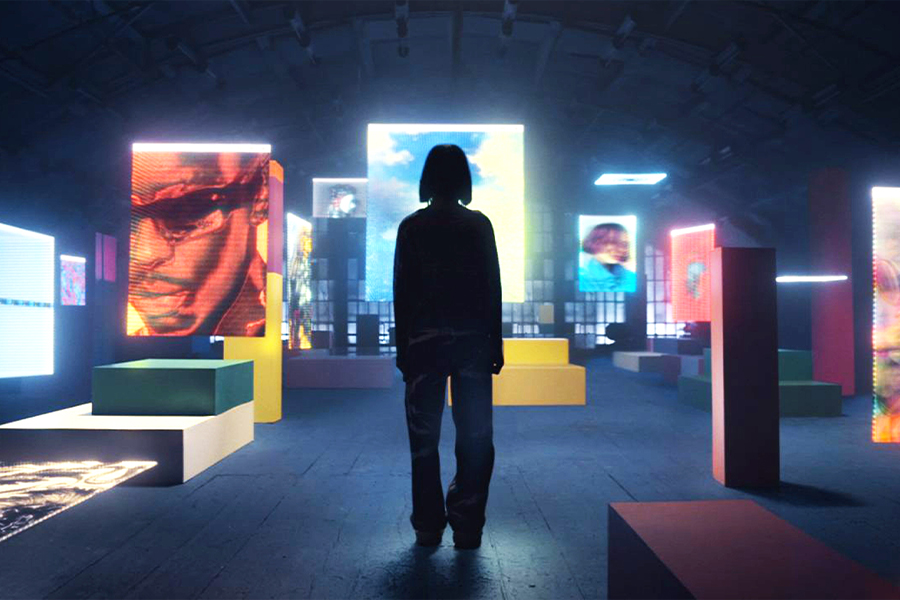What if we told you there was a scientific formula for creating extraordinary experiences?
We bet your interest would be piqued.
After all, if you’re reading this you already know that we’re living in an Experience Economy where normal doesn’t cut it, extraordinary is expected, and designers, marketers, entertainment producers and retailers are all locked in the battle for people’s attention.
Fortunately, one of our WXO Co-Founders is probably the world’s leading neuroscientist when it comes to the topic of immersion. He’s created software that measures levels of dopamine and oxytocin in the brain, enabling him and his team to track how immersive an experience is far more effectively than the traditional method of asking someone.
Neuroscientist Dr Paul Zak previously provided some brilliant insights into this immersion process in Measuring The Value Of Experiences. Now, upon the launch of his new book Immersion: The Science of the Extraordinary and Source of Happiness, he returned to reveal the principles you can use to create extraordinary experiences, based on his measurement of 50,000 brains over 15 years of research.

According to Zak:
- There’s a scientific formula to consistently create extraordinary experiences.
- The data shows that those who use this formula increase the impact of experiences tenfold.
- You can guess if your experience will be extraordinary – or you can apply his insights to ensure it is.
We’re big believers in the power of science-backed research and insights to elevate the art of experience design, resulting in better business. In the words of experience impresario and WXO Co-Founder Joe Pine:
“Staging engaging experiences has long been an art, but in the great Paul Zak’s capable hands, you will learn how to apply science to the task, tremendously enhancing your ability to create extraordinary experiences for your customers, your employees, and even yourself.”
Joe Pine
Read on to discover how Zak has turned his data into experience design gold, plus the brilliantly simple checklist you can use to make your own experiences extraordinary.
How Do You Measure Extraordinary?
For a deep dive into how Zak measures immersion, check out his earlier Campfire 9: Measuring The Value Of Experiences.
To create an extraordinary experience, you first need to know what exactly it is that you’re aiming for. If you don’t know where you’re going, any road will get you there!
“There are a ton of experiences that people put a lot of passion and effort into that fail: sometimes because of a lack of measurement, and sometimes because of a lack of clarity of outcomes. So first question: how do you know it’s amazing?”
Paul Zak
A starting point is to understand that humans are naturally lazy, as it takes so much metabolic energy to provoke us to act on something. Therefore if we manage to get people to take an action that is difficult or costly, it must have provoked something in their brain that makes them think that your experience must be shared, remembered or repeated. Enjoyment or liking alone isn’t a concrete or powerful enough state to rely on.
To understand what gets people to take these actions, Zak and his team measured signals in the brain using blood draws, ECGs and more, trying to find signals that would predict what people would do after an experience. In doing so, they identified an unusual neurologic state that hadn’t been previously explored: immersion. When this state was in play, it meant that people were sucked into an experience and were more likely to both remember and repeat it.
“Measurement is necessary because experiences have an emotional component that is produced in the unconscious areas of the brain. We think we can prod the brain and access this unconscious experience, but we can’t.
So we produced an ‘unfair fight’: we created a software platform in which subscribers use our technology to measure immersion in all kinds of weird experiences we’d never even have thought of, drawing insights from the data.”
Paul Zak
There may be some correlation between immersion and the concept of flow (for more on what makes a flow experience, see Campfire 30: How To Design For Flow). To Zak, however, immersion is different to flow because it is:
“…a self-reported psychological state in which you are actively engaged in a task, lose time and it’s enjoyable. Immersion is a signal that captures, whether the task is active or passive, your relationship with it.”
Paul Zak
Zak identified two key characteristics of immersion: “spotlight attention”, where a person is fully present in the experience, and “emotional resonance”, where they are emotionally engaged by it. He captured the electrical signals associated with these two characteristics at high frequency and reverse engineered the data to answer the question: if this experience was immersive, what happened to make it so?
I Don’t Care If You Like Me! Why Impact Is Better Than Enjoyment
As the above video demonstrates, asking people if they like something doesn’t necessarily give us the information we need to know.
“Experiences fail because we ask people about liking. I don’t care about liking: I care about it shaking up your brain so much it blows your mind.”
Paul Zak
It might sound counterintuitive, but immersion doesn’t necessarily correlate with enjoyment – and in fact, might run counter to it. Take the following experiment that Zak’s team conducted, whereby they measured the neurologic immersion of a group of people while watching big-budget Superbowl commercials.
Zak’s team compared these neurologic immersion scores against the USA Today rank, which asked people how much they liked each commercial. The results were surprising: an advert for Diet Coke Groove was one of the most hated according to USA Today, but was the most immersive.
This commercial is unabashedly weird: it’s asymmetric, features a custard-yellow wall with a tall woman dancing bizarrely, and an unforgivable socks and shoes combo. However, it showed large immersion peaks in Zak’s measurements. When he looked at YouTube buzz for all the commercials, there was a negative correlation with commercials people liked (i.e. fewer views and comments), and a positive correlation with those they were immersed in (i.e. more views and comments). There’s also a strong correlation between immersion and recall
In short? If we want to see impact, liking is the wrong measure. Immersion is where the groove’s at, as even a bad experience can have value.
“We’re designing for the anticipating, experiencing and remembering self, so even a bad or shocking experience is memorable and gives you a story and a sense of who you are. If you create an experience that immerses people, you’re giving them this social capital.”
James Wallman
How To Be SIRTA-n Of An Extraordinary Experience

Having established that for an experience to be extraordinary it needs to be immersive, Zak and his team analysed the data from over 50,000 brains to come up with a checklist for immersion: SIRTA. If you follow these elements in this order, you’re well on your way to extraordinary.
- Staging
In order for people to feel fully immersed in the environment, you need to create an environment that allows them to do so. This means making them comfortable, as comfort = more neural bandwidth for them to pay attention to your experience, one of the key characteristics of immersion.
If someone is hungry, tired, angry, stressed or cold, they’re spending brain power on those things rather than being in the moment. Take steps to remove these factors from your experience and give people a space to transition: bring down the lights, urge them to turn off their phones, and encourage them to leave the ordinary world and cross the threshold into your experience. (For more on this, see Campfire 12: Taking The Stairs Versus Crossing The Threshold.)
Patrick Hammond, who creates brand experiences for companies including Guinness, thinks of this as designing for reassurance.
“We create big physical spaces that people walk into, where even practical things like wayfinding are a way to give people the neural bandwidth they need a lot of. We try and enable people not so much to choose their own adventure, but to choose their own level – with Guinness, for example, a superfan might want to know everything about what goes into the beer, but my mum might only be interested in the founder’s backstory.”
Patrick Hammond
Is there a tension, therefore, between designing for anticipation/suspense and for comfort/familiarity? Zak thinks the key is in teasing that your audience is about to experience something new, but not too new.
“You want to build anticipation so they have an expectation of what’s going to happen, then create a moment of safety when they come in. Pre-event, perhaps drop some breadcrumbs to misdirect them, so they know something is going to happen but aren’t sure what. We also like something that’s new, but not too new – if I’m going to Jupiter I won’t have a point of reference, but I could infer some information from watching videos of the Moon, for example.”
Paul Zak
- Immersion

Your attentional response precedes emotional resonance. You have about 15 seconds to capture someone’s attention – and if you don’t, you’re unlikely to get it later on. Stage a “hot open”, then get someone to care about it by using human emotion, a sense of story, and creating a connection to characters.
“The most effective way to sustain immersion is to use a narrative congruent with your product or experience. Many ads have a beautiful story, but there’s no product congruence, so they fail.”
Paul Zak
We might argue that there are plenty of experiences that are highly immersive, but lack narrative – walking the dog, going to the park, making something or even having sex, for example. However, the brain requires some social content to be truly immersed.
“Immersion is a valuation mechanism in the brain for experiences with social content. There’s a blip of immersion in nature, as we start to anthropomorphise it – it can be a social experience communing with wild animals. Our lab shows that continuous immersion metrics can predict with 98% accuracy people’s mental wellness over the course of a month.”
Paul Zak
Peak immersion moments also provide an opportunity to give people a way to dissipate the tension you’ve built up on their brain and create a craving to repeat the experience – for example, allow them to recommend it, post about it online, or join your mailing list.
- Relevance
Your experience will have more impact if it’s relevant to the individuals within it. Customise it for your audience using iconography, music, geography, or any other tools at your disposal to pull on their emotions and memories and get them to feel: “this is for me”. (For examples of how to design for different cultural sensitivities, see Campfire 27: East And West Is Best.)
This triggers a process called “top-down control”. If something is relevant to a person, they get a push on the brain from the top down to the processing centres. So create different mini-experiences within your experience for different audiences to help them feel that it’s relevant for them. We might also think of this as personalisation at scale.
Zak gave an example of failing to score on relevance in some health commercials that the State of California produced to promote ObamaCare. To save money, they decided to use the same commercials for a Spanish audience, dubbing it in a Spanish voiceover. The average immersion for Spanish speakers was 70% less than for English speakers watching the original commercial in English, as it had no relevance: it didn’t speak to them. This insight reveals that it would be more effective to remake rather than reuse the commercials.
- Target

Find your superfans and put them to work for you. If you want to generate impact, send the something, tell them you love them, and they will spread the word for you.
Take the movie The Fault In Our Stars, for example. It cost $12m to produce, but grossed over $300m. This is due in no small part to the way in which they engaged with their superfans. They had a nationwide US competition where if people posted the most information about the movie, the stars would come to that state. They created a reason to see the movie more than once, offering $25 tickets that included attending a live feed with the stars afterwards. And they created social media states and fan fiction for them to congregate around.
- Action
Emotion is the driver of action: so if you provide a call to action at a peak immersion moment, your audience is more likely to be reactive. Don’t waste it!
An example of this would be skydiving. As soon as you touch the ground and emotion is coursing through your body, the team will offer you an annual subscription. You’re offered the option to be filmed so that you can relive the experience afterwards. And this video could be posted on their social media or websites to generate comments and allow people to watch the experience again and again.
The magic formula, in short:
Staging + Immersion + Relevance + Target + Action = Extraordinary Experience
How Immersion Can Help Us Design For Difference

Working with huge data pools can be invaluable for gathering insights, but it also threatens to focus our attention on averages rather than accounting for the nuances of individual experience. Fellow neuroscientist Doug Steel wanted to know whether Zak’s immersion data pointed towards designing for the mean or the outliers.
“For some physiological responses everyone is uniform, in some there are high and low responders, and in others people are a smudge. If you take 50 people you have 50 different responses in terms of slope of response. With your data, are you dealing with universal, high/low or different responses?”
Doug Steel
The key is in thinking about both how to raise the average immersion, but also to pay attention to what’s happening at the extremes.
“The dirty secret in neuroscience is that averages aren’t very meaningful – it’s variation that’s interesting. If I compare lots of people, that gives me a baseline that I then remove. I want average immersion to be higher, but I also want to think about the tails of distribution – who digs it, and who does it fail for?”
Paul Zak
Different people will have different things that make them feel neurologically safe, so knowing this distribution will help design for them in a way that focusing on the average never would.
“If you design for average, you might not be designing for anyone.”
James Wallman
Immersion might even help us understand how much impact an experience has on those who can’t respond to normal feedback methods, such as neurodivergent people with conditions like dementia.
“These signals occur deep in the brain stem, so they’re quite well preserved across different disorders.”
Paul Zak
Does Immersion Aid Or Threaten Innovation?

In the fight for consumers’ attention, continuous innovation is crucial. However, Louis Alfieri wondered if tools like Zak’s might actually harm creativity and human innovation, leaving it vulnerable to being superseded by machine learning.
“A lot of movie studios have started looking at how to write scripts using machine learning to ensure commercial success. You already see it happening with art and illustration, with programs using algorithms and predictive analytics to create work. How do we ensure these tools are used as tools of optimisation, and not to supplant creativity?”
Louis Alfieri
Zak contends that the problem with machine learning is that it’s good at picking up where things are going, but not virtuosity or the unexplained and unexpected.
“We still need what I call “creative plus” – that innovation that computers and AI can’t capture yet.”
Paul Zak
And by applying SIRTA to our experiences, we can showcase this innovation and get ahead of the competition. Lou Murray gave the example of fellow WXO Member Theron Skees’ work on developing Disney Springs at Walt Disney World.
“He got to live SIRTA by being asked to innovate from an architectural way of presenting to a fully immersive, projection-centric experience. If you want to create a real-life immersive environment where you completely change the story, you also need to find an innovative way to tell that story. He got retailers to sign a multimillion-dollar lease at the end of the presentation. You do this by showing a virtuosity in design that will get people to aspire to where you want them to go. This is what we have to be on a quest to do – we need to up the game continuously. You can’t be ordinary.”
Lou Murray
The WXO Take-Out

We’re always on the lookout for tools that we can adapt to build better experiences, whichever sector of the Experience Economy we specialise in – and we think Zak’s SIRTA checklist is an elegant encapsulation of several key tenets of experience design, including designing for the anticipating, experiencing and remembering selves, creating a relatable human narrative, and building in opportunities for audiences to co-create and drive the action.
We also think that where these tools are backed up by measurable data and scientific research, it gives us an even better opportunity to tell the story of our experiences and prove their value.
So next time you’re designing an experience and want to make it extraordinary, ask yourself:
- What is the neurologic basis for extraordinary experiences?
- What design principles increase the likelihood of the extraordinary occurring?
- Why do people crave repetition of the extraordinary, and how does this affect their happiness?
To continue the conversation, WXO Members can head to the topic on My WXO here.
To see the full line-up for the WXO Campfires Season 5, click here.
To apply to join the WXO and attend future Campfires, click here.





